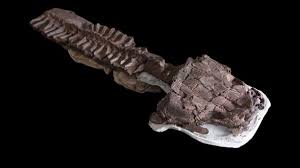A staff of scientists in Namibia has found a big creature with a two-foot cranium and large pointed enamel. This large creature lived in swampy water lengthy earlier than the dinosaurs got here to land. This analysis has been reported in a analysis printed within the journal Nature on Wednesday. This species has been named Giacea Jenya. It was a tetrapod like a salamander. The authors of the analysis say that the fossils present that it was a bit feeder, which additionally had a strong tooth to catch massive prey and its head was like a bathroom seat.
Gaisia Jenya existed about 280 million years in the past. This animal was discovered about 40 million years earlier than the dinosaurs developed. Its cranium was greater than 2 ft lengthy. Researchers estimate that this animal was 8.2 ft (2.5 meters) lengthy. Jason Pardo, a researcher on the Discipline Museum in Chicago and creator of the examine, has mentioned that Gesia Jenya was a lot bigger than an individual and lived close to swamps and lakes. Its jaws had been interconnected which enabled it to hunt. Researchers consider that it was the apex predator in its swampy ecosystem.

Genya was within the southern a part of the supercontinent Gondwana
Pardo mentioned in his assertion that this animal has a big, flat, bathroom seat-sized head, which permits it to open its mouth and suck the prey. It has large pointed enamel and only one large tooth in all the entrance of the mouth. Researchers found the fossils within the Gaias Formation in northwestern Namibia. Genya existed within the southern a part of the supercontinent Gondwana.

The analysis staff has found 4 fossils, together with cranium fragments and a vertebral column. Researcher Claudia Marsicano mentioned that after we discovered this large specimen mendacity on the outcrop as an enormous concretion, it was actually stunning. This was one thing utterly totally different. We had been all very excited. He defined that on the time Genya lived, trendy Namibia lay to the south, roughly parallel to the northernmost level of Antarctica right this moment. The ice age was ending whereas the land close to the equator started to dry out and new animals had been evolving.




